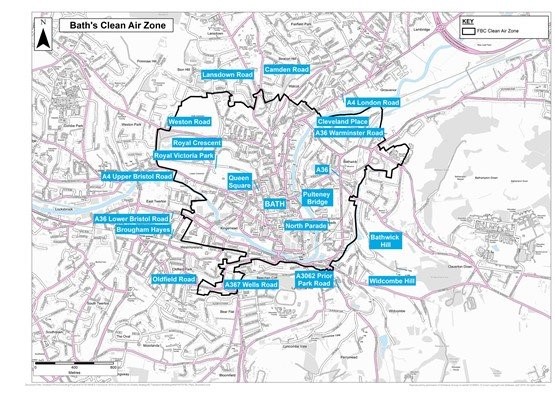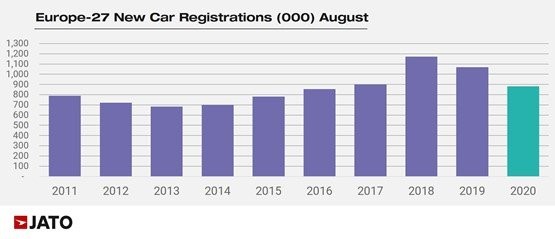Bath To Become First City To Introduce Clean Air Zone Outside Of London
Thursday, 22. October 2020
Bath will launch the first charging clean air zone (CAZ) outside London in March, next year.
The announcement comes as new data, released by the UK Government and analysed by environmental law charity ClientEarth, reveal that three quarters of air quality reporting zones still chart illegal levels of air pollution.
Bath’s CAZ had been due to be switched on in November but was delayed due to the coronavirus pandemic.
Bath & North East Somerset Council says it considered air quality, traffic levels and the impacts of Covid-19 on local businesses and the economy, before agreeing the new start date of March 15, with the Government.
However, it said that the date will be monitored to account for any significant developments during the ongoing coronavirus pandemic.
The council is currently contacting more than 9,000 local businesses to help them establish whether charges will apply to their vehicles, and how to access the support on offer.
The CAZ will operate in the city centre 24 hours a day, seven days a week, 365 days a year.
Charges will apply to pre-euro 6/VI diesel and pre-euro 4 petrol vehicles, except cars and motorbikes.
Non-compliant vans, taxis and minibuses will be charged £9, while non-compliant trucks and lorries, and coaches and buses face a daily charge of £100.
The council has also announced financial support to help fleets upgrade to compliant vehicles. Local businesses including those in neighbouring authorities that have premises and/or regularly drive in the zone, can apply.
For example, it says that eligible van drivers could receive up to £4,500 in grants, plus interest-free finance, to help them upgrade to a similar, compliant vehicle.
Larger grants are available of up to £20,000 for HGVs and £35,000 for buses and coaches.
In light of Covid-19, the council has also amended the scheme so that if eligible businesses fail their initial credit check, they can re-apply once their finances have improved.
In addition, these drivers would be able to apply for exemptions on their non-compliant vehicles for up to two years.
There are also a wide range of exemptions available for hard-to-replace or special vehicles, and to support disadvantaged groups and vital services in the city, it said.
Furthermore, discounts will be available for drivers of larger, higher emission motorhomes and horse-transporters (private heavy goods vehicles) who can pay £9 instead of £100 provided they register with the council. Applications for all local exemptions and discounted vehicles will open in November.
Leader of the council, councillor Dine Romero, said: “In 2017, the government directed us to reduce levels of nitrogen dioxide in the city in the shortest possible time. Technical work showed that a charging zone was the only measure that could achieve compliance in the time frame we were given.
“The council consulted widely on this and agreed to introduce a class C charging CAZ with traffic management at Queen Square, charging all higher emission vehicles, except private cars and motorcycles, to drive in Bath’s city centre.
“However, there is no getting away from the fact that Covid-19 has had a significant impact on many businesses and this will be an additional cost that they have to consider.
“We have worked hard to secure a considerable package of financial and other support to help business owners and I would urge them to get in touch, talk to us and find out how we can help.
“We all want clean air and the zone is a step towards our wider ambitions for Bath and North East Somerset to address air quality and tackle the climate emergency.”

The council secured a total funding package of £23.4m to implement the scheme and provide supporting measures, such as the financial assistance scheme.
This is made up of £18.4m of capital funding, comprising £7.1m for implementation of the scheme and £11.3m for supporting measures.
This total funding award aligns with the earlier settlements received by both Leeds and Birmingham.
Bath’s decision to plough ahead with its CAZ, however, comes as other local authorities pause their plans.
Bristol City Council may yet still reverse its plan to introduce CAZ and is looking at alternative options to improve air quality.
It follows a decision by Leeds City Council to rethink its CAZ plans.
As a result of the coronavirus pandemic, Bristol’s mayor Marvin Rees said travel habits in the city are changing and its pollution levels are lower.
“Our plans have always been about cleaning up our air in the fastest possible time and not being anchored to one method,” explained Rees.
ClientEarth, however, has highlighted new figures that show that in 2019, the Government was still breaching legal limits for nitrogen dioxide (NO2) pollution – limits that should have been met in 2010 – in 33 out of the 43 national reporting zones.
While it acknowledges the lockdown led to a decrease in NO2 levels in some areas, traffic and pollution levels are already back on the rise in many towns and cities, it says.
ClientEarth lawyers are urging the Government and local authorities not to rely on temporary dips experienced during lockdown to evade action.
Katie Nield, UK clean air lawyer at ClientEarth, said: “It is clear that the pandemic will not solve the problem in the long-term, with pollution already lurching back to pre-lockdown levels.
“Government evidence shows that clean air zones are the most effective way of quickly slashing illegal pollution levels.
“We know that when backed by help and support for people and businesses to move to cleaner forms of transport, these schemes can really make a difference.”
Mark Footman, operations director at same day delivery business CitySprint, said:“As a consequence of the reduction in traffic and vehicles on the road, there has been some temporary improvement in pollution and air quality in urban areas. But despite this, it’s really vital that these important issues do not slip down the agenda.
“As we look towards economic recovery, it’s essential that we do not lose sight of the progress that has been made around sustainability. As such, it is concerning to read of the potential delay or abandonment of some of the proposed clean air zones being rolled out across the country.
“With ULEZ, London has shown that this can work and make a tangible positive difference.
“We know sustainability remains a big focus for UK businesses, and the logistics industry has long understood the importance of reducing the impact of its operation on the environment.
“However, the high price of green vehicles is slowing down progress. And, with the sales ban on carbon dioxide-emitting engines potentially being brought forward, it is crucial that these high costs are addressed.
“Indeed, a push to make greener vehicles more affordable, further investment in infrastructure and the encouragement of better consolidation of deliveries will help to reduce emissions in the industry.”
The British Vehicle Rental and Leasing Association (BVRLA) wants the Government to introduce a nationwide digital payment platform that provides a clear, consistent and proactive way for fleets to manage multiple vehicles entering multiple zones on a daily basis.
A similar ‘auto pay’ function to that used on the Dart Crossing is essential, because it would enable fleets to register their vehicles and have them charged automatically as they enter a CAZ, it says.
Furthermore, it wants local authorities must provide targeted financial assistance to firms that need support in upgrading their vans or trucks. These funds should be accessible for leased or rented vehicles – which thousands of businesses and individuals rely on for their transport needs.
BVRLA chief executive, Gerry Keaney, said: “Our members have a fleet of CAZ-compliant cars, vans and trucks ready to help businesses or individuals upgrade their vehicles to cleaner alternatives. We would advise people to consider their options now, to ensure that they can get the right vehicles in place at the right time.” By Graham Hill thanks to Fleet News

























